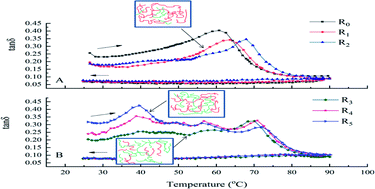Phase separation affects the rheological properties of starch dough fortified with fish actomyosin†
Abstract
Starch and protein are common polymers in food, and their phase separation often occurs during food processing. Protein-fortified starch dough can be considered as a triple phase separation system, and the effect of phase separation on dough rheology warrants further research. In this study, starch doughs fortified with fish actomyosin were used, and their rheological properties were researched and explained with respect to phase separation. The results suggested that the phase separation of actomyosin-binder-starch granules in the raw dough affected the quality of dough. The addition of actomyosin significantly decreased stiffness and shear sensitivity but increased the fluidity of the blended dough. Moreover, it was found that the interaction between mung bean starch and actomyosin was very weak. The polymer molecules were connected by physical links. Owing to phase separation, it was presumed that “wall slip” occurred between the binder, starch granule, and actomyosin. The blended dough containing 30% of the added actomyosin (R3) showed the best recovery ability and the weakest molecular interaction (interaction type Z′ = 0.40 for storage modulus G′ and 0.31 for loss modulus G′′). Additionally, the phase structure of the model doughs was investigated. It was found that the starch network played a dominant role when 10% (R1) actomyosin was added. With the addition of actomyosin, the protein network formed gradually. A bicontinuous phase structure with interpenetrating network was observed in R3 (actomyosin = 30%). In summary, our findings demonstrate the feasibility to make blended doughs by mixing fish actomyosin and mung bean starch. Moreover, in terms of use in traditional noodle making, the blended R3 dough was found to be the best in terms of recovery ability and flow characteristics.



 Please wait while we load your content...
Please wait while we load your content...